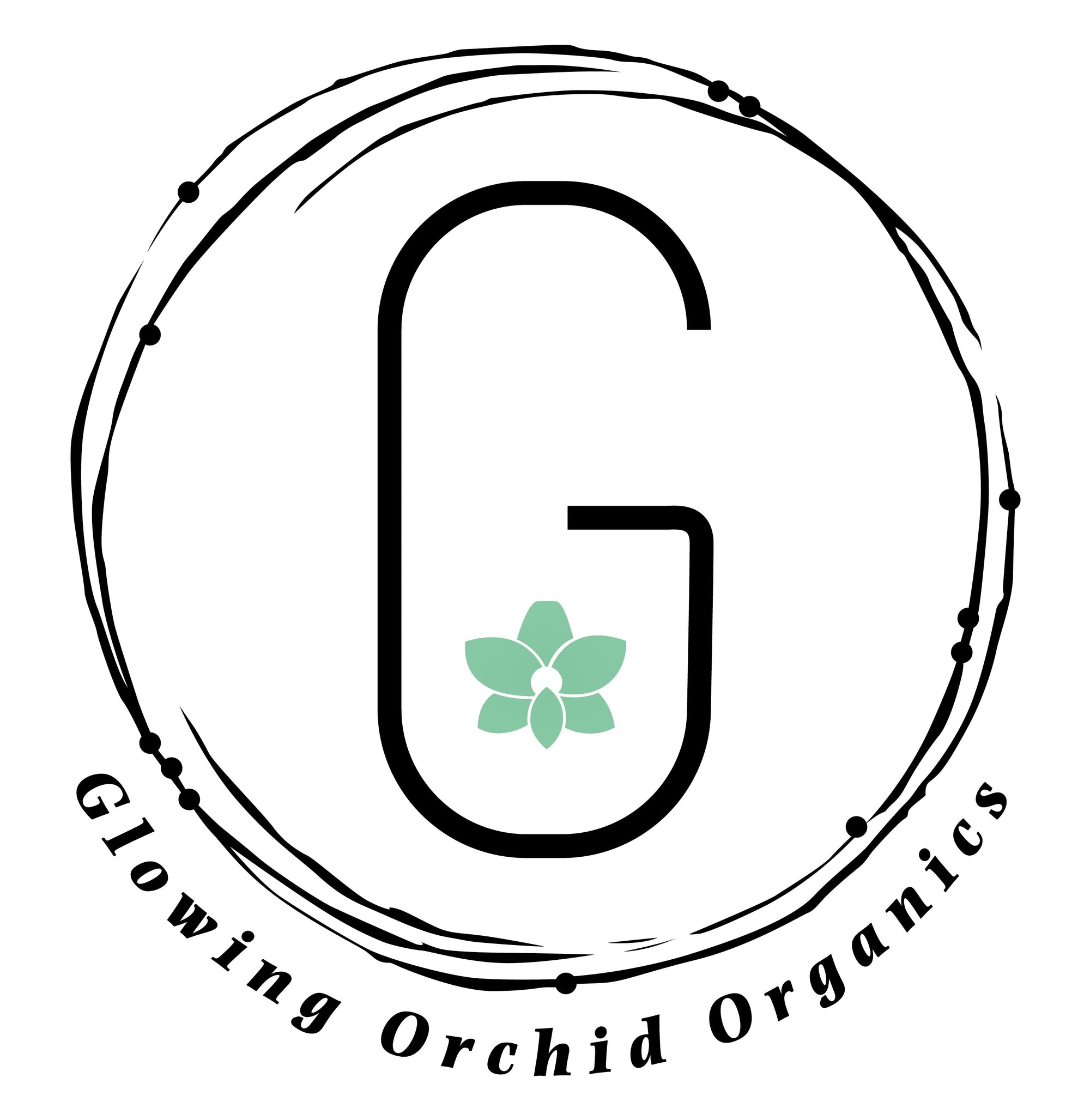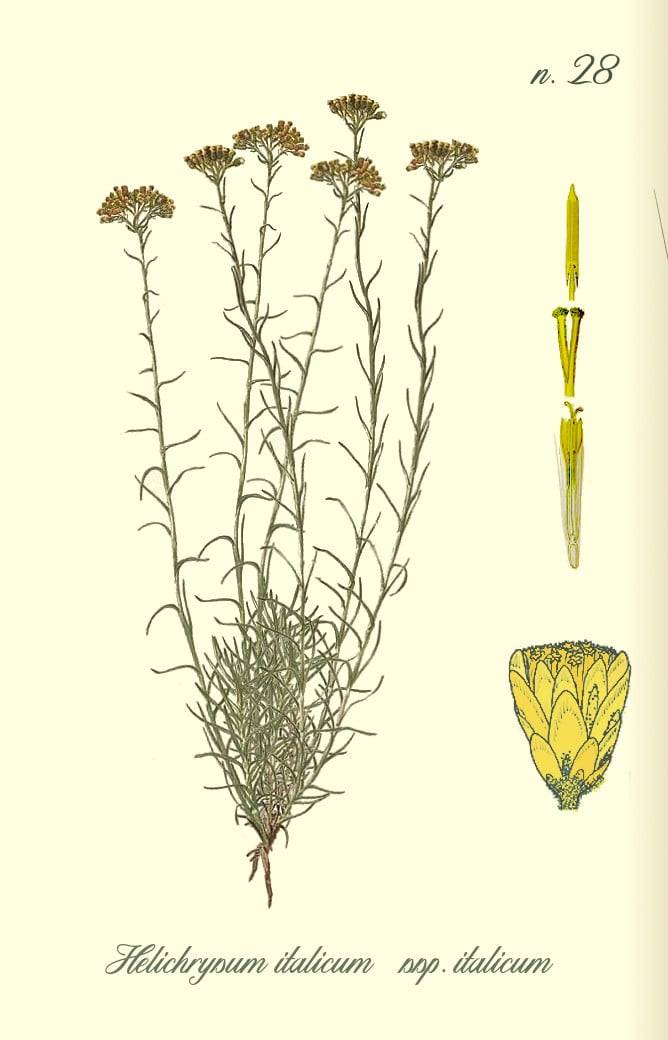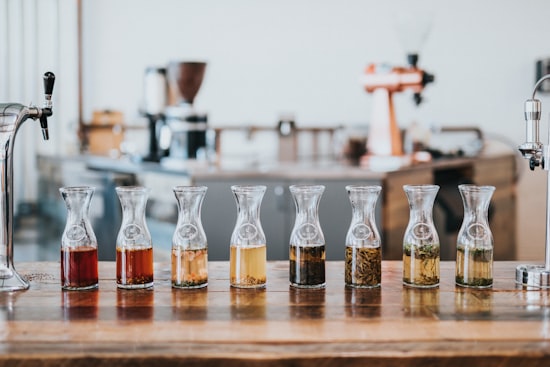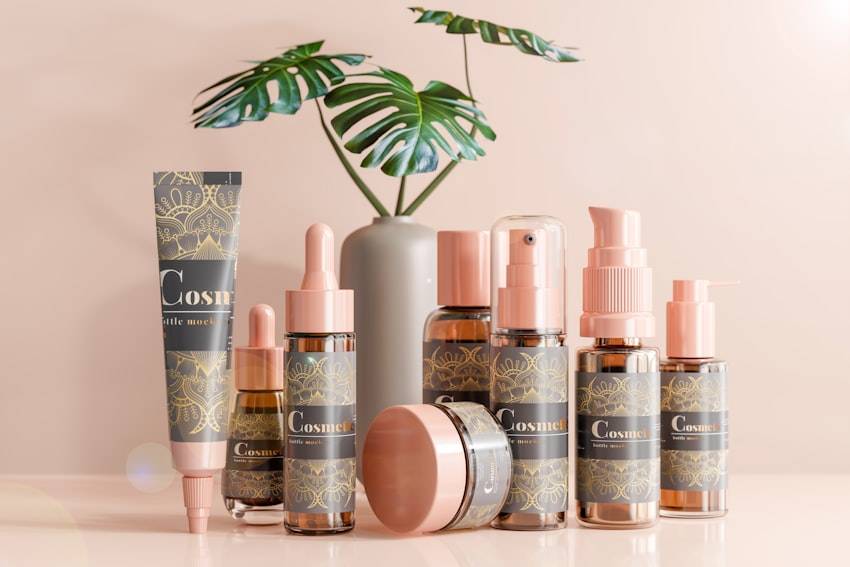If we had to choose just one essential oil as our ultimate favourite for skincare, we’d pick helichrysum oil, hands down. In fact, we already infuse this powerful ingredient in many of our products, and we’ve consistently gotten rave reviews for them. (I myself am one of those who just can’t get enough of helichrysum-infused products!)
So what is this fantastic essential oil and how does it work? We want to share with you the science behind it, and how you can use it in your own regimen, too.
What Is Helichrysum Essential Oil? Where Is It From?
Helichrysum oil is a plant-derived essential oil that is used for many cosmetic and medicinal purposes, primarily for skin healing. It’s derived from a pretty, herbaceous flower of the same name. There are more than 600 species of the helichrysum flower, but the essential oil is most commonly extracted from the Helichrysum italicum species.
Helichrysum flowers are actually cousins of the sunflower, and they usually have the same bright yellow color, too. Fun fact: the word helichrysum comes from the Greek helios, which means sun, and chrysos, which means gold. The flowers are also called “everlasting” and “immortelle” because they retain their vibrant color for a long time, even after being cut. How interesting are these names!
These flowers love the sun, so they thrive in the Mediterranean, Asia, and Africa. In these regions, these shrub-like plants have long been used in traditional medicine to heal wounds and treat coughs (we’ll get to these health benefits in a bit).
Modern extraction methods now give us helichrysum essential oil that has a long shelf life (that’s why the oil itself, like the flower, is also sometimes called everlasting). The substance comes in yellow to red colors, and is somewhat watery. It has an intense but lovely odour, with undertones of honey and fruit. Yes, even its scent is so luxurious and makes you all the more eager to use it!
Medicinal History Of Helichrysum Oil: Uses And Benefits
The helichrysum plant has been popular in traditional medicine for centuries. I’m a fan of this herb and how it has been developed today, so I did some reading into how cultures have been using this plant in their time-tested folk medicine.
Among some tribes in Africa, helichrysum leaves and stems are burned like incense to ease coughs, colds, and headaches. There is even a practice in Mozambique where tuberculosis patients found relief by drying helichrysum roots, placing them on hot coals, and inhaling the smoke under a blanket.
I don’t know how I could’ve lasted around smoke, but the interesting thing about this is that modern-day scientific research has in fact found mucolytic and expectorant properties in helichrysum. Those are the same main properties in many of our cough meds today!
There’s more wonderful history around the helichrysum plant in the Mediterranean. Mentions of the plant is found in many classical medical treatises in Greco-Roman traditions. For instance, Theophrastus described in Historia Plantarum -- way, way back in 3rd century BCE -- how they would mix helichrysum with honey and apply it on the skin to treat wounds and burns.
Other medical pioneers and botanists also wrote about the pain-relieving abilities of the plant. I particularly liked that they made medicinal wine from helichrysum to treat sciatica and other arthritic conditions, as well as other back and hip pains.
In more recent history, Italian presidents have been noted fans of helichrysum herbal teas. They actually have drinks called tisana del Quirinale (“Quirinale” being Italy’s version of the White House), and these drinks have a dreamy mixture of helichrysum and lavender. (Psst! I found a quick infusion recipe for Quirinale tea, but it’s in Italian, so Google Translate may just be your friend.)
All over Italy, households traditionally use helichrysum for more topical purposes. They combine it with olive oil and apply it as treatment for sunburns, fire burns, and wounds. Leave it to the Italians to make wound-healing classy!
Skincare Benefits Of Helichrysum Essential Oil
As helichrysum gets more and more recognized in mainstream pharmacology, there are new scientific studies everywhere that support its many health benefits. Just a snippet of the long list of these benefits: helichrysum has anti-inflammatory, antimicrobial, digestive, diuretic, expectorant, and pain-relieving properties. And that’s only naming some of them!
When it comes to cosmetics and skincare, helichrysum offers not just one but three amazing benefits to keep your skin glowing:
- This essential oil acts as an antioxidant that protects the skin’s collagen and elastin.
- It wipes out microbes that harm the skin.
- It has tissue remodeling effects to fade blemishes.
In simpler terms, it fights skin aging and helps our skin tissues recover fast from damage!
Let’s look a little deeper into these beauty benefits:
Helichrysum Essential Oil: Antioxidant Properties Promoting Skin Collagen And Elastin
Collagen is the main protein component of our skin, while elastin is the protein that gives it elasticity (skin can return to its original shape after being stretched, pinched, pulled, etc). When our skin is well-nourished with these proteins, it becomes naturally smooth, firm, and supple.
But as we all know, our skin’s components degrade as we age and the more we get exposed to sunlight and harsh elements. To be more specific, there are enzymes called collagenase and elastase that degrade our skin’s needed proteins, and these enzymes are activated by factors like UV rays and free radicals in the environment.
This process of breaking down our skin proteins is called oxidative stress or oxidation. The visible result? Our skin becomes more prone to wrinkles, sagging, stretch marks, and scars.
So, oxidative stress = bad for skin. Hence, we need tools called antioxidants to protect our skin from oxidation.
Enter helichrysum oil, a fantastic antioxidant. Research has found that this specific essential oil inhibits the activity of collagenase and elastase, thus protecting our skin’s integrity and elasticity. This anti-aging mechanism is mostly attributed to a molecule called Beta-diketone. A potent type of B-diketone is called italidione, and it’s found in -- surprise, surprise -- Helichrysum italicum.
So alongside a good diet and ample physical protection from harsh environments, we highly recommend leveraging the benefits of helichrysum oil to help retain that youthful glow. And you thought CBD was cool? ;)
Helichrysum Essential Oil As An Antimicrobial Skin Healer
Of course, even the most youthful skin isn’t exempt from the occasional cuts, scrapes, and blemishes. Sometimes, even the most immaculate complexions get acne, too! A sneaky little secret to heal these quickly? That’s right -- helichrysum EO.
We’ve mentioned above how traditional medicine has relied a lot on helichrysum plants to treat wounds. A primary reason why it works is that this plant’s extract has a substance called curcumene, known for its wound-healing action. You may have heard of this substance as a component of turmeric, but the New York Institute of Aromatic Studies lists curcumene as a major component of helichrysum oil as well.
Helichrysum’s curcumene is anti-inflammatory and antiseptic, which leaves no chance for bacteria and fungi to linger on the wound. Combine this with the oil’s collagen-promoting italidiones, and you’ve got skin that’s swiftly resilient against damage. Say bye-bye to small cuts and pesky pimples in a jiffy!
The oil’s abilities isn’t just for treating skin lesions after they’ve appeared. I love that the antibacterial quality of helichrysum helps prevent acne altogether, so I don’t have to worry about random breakouts at all!
Helichrysum Essential Oil’s Tissue Remodeling Effects
As if helichrysum’s wound-healing power wasn’t enough, this essential oil is also established to have “tissue remodeling” effects that help maintain unblemished skin. If you’re wondering what “tissue remodeling” even means, take a few minutes to read on because this is pretty astounding.
In skincare-speak, tissue remodeling is the final stage of wound healing. This is when the scarred-over skin tissue attempts to go back to its original appearance. How? By breaking down its collagen pileup.
But isn’t collagen needed by our skin? Yes, it is. However, during wound-healing, our body naturally deploys extra collagen on the wound in an effort to close it up. Collagen types I and III are particularly dominant in this process. This is how we get those unsightly marks, scabs, and keloid scars after a wound closes.
Now, it is normal and quite common for scars to take too long to disappear, which is why a lot of us need help in the tissue remodeling stage. Sure, there are tons of over-the-counter creams for scar fading, but helichrysum essential oil is an all-natural and highly effective alternative. One study specifically found that helichrysum oil significantly inhibits the production of collagen I and III over a wound -- exactly the action we need to fade those show-stealing scars.
At the same time, as we’ve learned above, helichrysum helps our skin rejuvenate by protecting it from oxidation. This oil basically covers the two parts of tissue remodeling: diminishing the extra scar collagen and promoting healthy new skin in its place.
The even greater news is that this works not only on cuts and scrapes, but also on other blemishes such as pimple scars, stretchmarks, surgical marks, and even old, stubborn scars. If you have a noticeable mark that’s persisted for months, helichrysum oil is definitely worth a try.
How To Use Helichrysum Oil For Skincare
Anti-aging, wound-healing, scar-fading -- helichrysum essential oil is one powerful beauty trick! You can apply it topically on the affected portion of your skin. Just two to four drops of undiluted helichrysum EO is enough (do a patch test first!). However, we recommend mixing it with a carrier oil to create a nice, soothing rub. Jojoba oil makes a good pair for helichrysum, and so do avocado oil and coconut oil. (You can also make like Italians and mix helichrysum with olive oil, too.)
If you want a less direct (but equally relaxing) way to benefit from helichrysum, you can use it aromatically. Like most EOs, you can diffuse this oil at home, inhale it directly, or add a few drops to your bath.
To unlock its internal benefits, you can also dilute helichrysum oil and drink it. (DYOR first of course!) Dilution is really vital here because the oil is so rich. Just one drop should be mixed with about four ounces of water. Also, this oil is an anticoagulant, which makes it inadvisable for those who’ve recently had surgery, are pregnant, have hemorrhage problems, or have similar health concerns.
Our most recommended way to use helichrysum oil for your skin? Why, through Glowing Orchid products, of course! We’re super proud of our helichrysum-infused face creams, eye creams, and serums -- and we’re happy that our customers love them as much as we do!
Ready to give it a whirl? Try our popular Helichrysum & Frankincense Facial Creme, or our Scar Light, Skin Bright Roll-on Serum, for starters. Like the rest of our helichrysum products, they work like a charm, plus they feel and smell heavenly (one of the reasons I’m crazy about them)!
Give these a whirl and tell me how well helichrysum works for you!
xx Judit
Additional References and Further Reading
“Helichrysum Essential Oil Benefits the Skin, Gut, Heart & More” on Dr. Axe
“Helichrysum Oil Can Offer Heaps of Health Benefits” on Mercola
“Helichrysum italicum: From traditional to use to scientific data” on ResearchGate
“Helichrysum” on Herbal Africa










